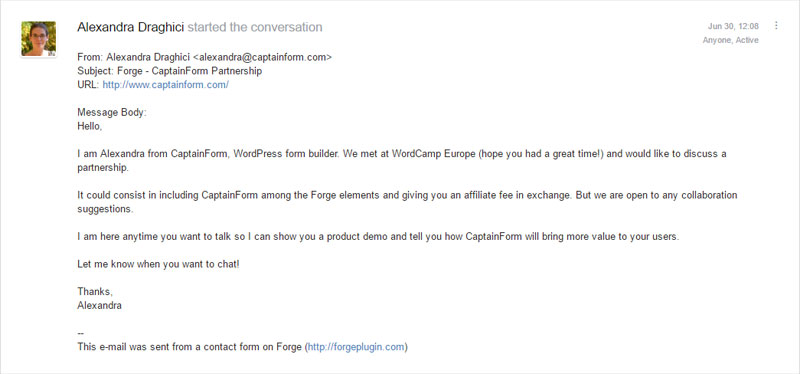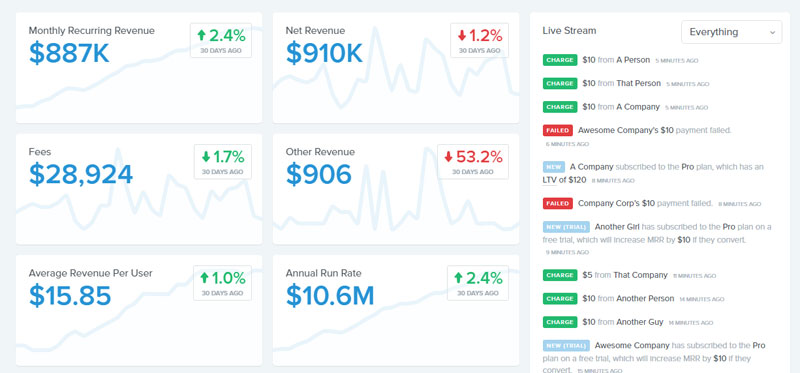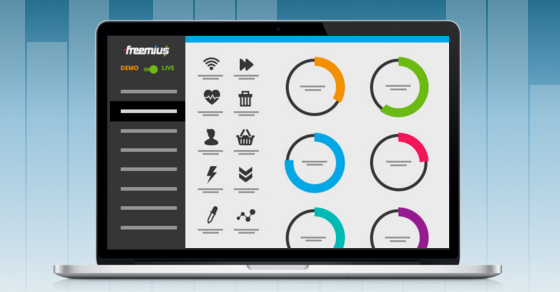|
|
Building a great WordPress plugin is hard.
There are many different aspects to consider during the planning phase– you have to develop a solid codebase, and also craft a great user experience. But that’s only half the job. The hardest part of creating a commercial plugin is not developing it — it’s getting people to use it and growing your user base.
A while ago, we managed to launch a page builder plugin named Forge (Editor’s note: the Forge plugin is no longer maintained). It is a freemium plugin — people can use it for free, and then upgrade with some paid extensions. And the actual challenge of creating Forge was not the plugin itself, but rather promoting it.
Here’s what we did.
Promoting Your Freemium Plugin
The freemium business model has a number of advantages when it comes to promoting your product. It is easier to sell by nature, because just about anybody can try your newly-released plugin without risk.
However, just having a free product is not enough. You still need a promotion strategy in place, because people are not going to use your plugin just like that.
In fact, the main problem when you are starting out is that nobody knows you exist.
You’ll need a promotion strategy in place. People are not going to use your plugin just like that.
When building Forge, we tried a number of things to get the word out. Some worked out well for us, some did not. Here are the results of our efforts, and the lessons that we learned along the way:
Lesson #1: Build Your Minimum Viable Plugin
When building Forge, the very first thing we wanted was validation. We had worked with a great deal of clients before, so we had a fairly good idea of what people needed when building a WordPress website.
But having a product that works for a small number of use cases is not the same as creating something for the masses. And to validate, we needed to launch as soon as possible.
Therefore, we set out to build an MVP (Minimum Viable Plugin). This product would have only the bare essentials that made the idea work, and lack anything else. In Forge’s case, the most critical features were:
- A drag and drop interface
- Publishing system for posts
- Layout tools such as rows and columns
- Text blocks, headings and image elements
The very first version of Forge barely had any features, but the core experience was there. The base functionality of the plugin allowed users to create content using a drag and drop interface, and that was enough to release.
From then on, it was all about refining the product, releasing extensions, and other free tools such as Furnace (a free theme).
Having an MVP can really help with promotion. For starters, it helped us determine what users actually wanted by getting a lot of feedback. It also allowed us to create a beta phase, where we would invite users to try out the tool and have them voice their opinion.
All of this was instrumental in getting our first users and defining our feature roadmap.
Lesson #2: Asking For Reviews, The Right Way
It’s hard to get people to review your product. Very hard. When someone leaves a review, it’s usually because of two primary reasons:
- They are thrilled by your product
- They want to bash your product
Basically, either people love or hate you– It’s hard to find a middle ground.
But getting good reviews is a great way to promote your freemium WordPress plugin. And most likely, the vast majority of your users will like your plugin. They just don’t like it that much to leave a review.
It may seem surprising, but the best way to get a review is usually the simplest one: you can just ask.
For instance, the Forge plugin itself asks for a review — but in a sensible manner. It appears only once, waits until seven days have passed so that you can try it out first, and does not appear to minor users or non-admins. Also, appearing more human really helps, so don’t be afraid to convey your actual feelings.
Appearing more human really helps, so don’t be afraid to convey your actual feelings.
Asking for a review is asking for an investment
When asking someone to review your product, you must keep in mind one thing: you are asking them to make an investment. Someone writing a review for you means they are putting in their time and effort to do something for you– and for many, time is an invaluable resource.
One thing that helps with reviews is rewarding users. I’m not talking about incentivized reviews — Those are forbidden in the official repository and will get you banned.
Instead, I am talking about providing a positive experience from start to finish:
- Be helpful and devote some effort to solving users’ problems
- Provide a real solution even if the user is not a customer
- Make sure the plugin is easy to use and provides real value
- In general, treat users well and delight them
Doing these things takes quite a bit of time and effort. But in the long run, it’s the kind of thing that will make users want to return the favor. If you help someone without asking for anything in exchange, they will be more inclined to help you back.
Afterwards, all you have to do is ask with a simple admin notice or an email.
Lesson #3: Building Partnerships With Other Plugins
A while ago, we attended WordCamp Europe in Vienna. It was packed with WordPress people, including freelancers and plugin authors.
While attending big events is a great way to make connections and getting to know the community, it can also help you with strategic partnerships.
For example, back in Vienna we met up with the guys behind CaptainForm. They were a great team to be around, but we also reached an agreement: Our Forge plugin would directly integrate with their CaptainForm plugin, providing an easy way to embed forms using drag and drop.

This way, we would both get exposure from each other’s audience, while at the same time creating value for end-users.
These kind of strategic partnerships are what will push your product forward. Just look at what Baremetrics did– they offered Buffer an easy way to be transparent about their financials, and that has resulted in massive exposure:

Lesson #4: Mass Emailing Done Carefully
To get people to know our product, we also tried sending emails to a lot of potential users.
The premise is simple: it’s not that your product is good or bad– people simply don’t know that it exists. The general idea behind these emails is to generate awareness, and then people can decide whether to use your new freemium plugin or not.
However, there is a fine line between self-promotion and spam. If you have a WordPress website, chances are that you have received something like this some time:
Hello!
I am XXX, the creator behind AWESOME plugin.
It allows you to do this and that, and you should definitely try it out. For more info, visit our website at awesomeplugin.com.
Best regards,
XXX
Would you like to try that awesome plugin? I would not.
When we tried cold-emailing people, we did so focusing on two key aspects:
- Segmenting to people who might actually benefit from this plugin
- Providing something of value first, and not asking for anything
Forge is most useful to people that have their own websites, and have to create landing pages or intricate layouts regularly. Therefore, we tried segmenting to only bloggers that have a focus on marketing.
In addition to that, we tried to make our email as friendly as possible– not to get a sale, but only to raise awareness about our plugin.
Just like with reviews, asking someone to try your plugin is like asking for an upfront investment; they have to spend time on your tool instead of doing other stuff. They may like the plugin, or they may not. In fact, there is nothing to assure them that your plugin is actually any good.
Here’s the email we sent out:
Hi NAME!
I am Manuel Vicedo, a WordPress developer. I’ve been lurking on your
blog for a while, and frankly, I really love your way of telling
stories to keep your community glued.I wanted to let you know about a new page builder I’ve been working on
named Forge. It launched last November, but it’s already got plenty of
stuff to show off. It has an almost perfect 5-star rating in the
official plugin repository:I’d love it if you could give it a try. I’ve put my heart and soul
into it, and I’m sure you will be surprised by its potential. And of
course, we have an affiliate program as well.Let me know if you are interested, and I can send you a free copy.
Manuel
Notice how there are a few key aspects in this email:
- I addressed the blogger by his name, instead of some generic greeting.
- I actually took the time to check out what his site is about, and what it does.
- I was straightforward with no excuses or fluff, their time is valuable.
- I mentioned the almost-perfect rating of the plugin to provide social proof.
- I mentioned the affiliate program, in case the blogger is interested.
- I offered a free copy of the premium version, with no strings attached.
In summary, it’s all about reaching to potential users at a personal level. Since you are essentially asking them to make an effort, you must compensate them in any way you can beforehand.
In our case, we had mild success with cold emailing. A few great bloggers wrote pretty good reviews (such as Enstine Muki), while others mentioned the plugin on social media. Since you’re basically asking people to do stuff for you for free, simply getting a small number of reviews is already a huge success.
What Did Not Work
On the other hand, we also tried a few things that didn’t work out as well as we hoped. Most of these involved paid advertising:
Paid Advertising (PPC): We expected paid advertising to produce better results, but it was a bit disappointing. Click-through rates weren’t nearly as high as we hoped, and simply having a free version was a much better way of attracting visitors.
Paid reviews. Just like with paid advertising, we hoped to create some initial traction by reaching out to big-name players in the WordPress industry. However, the results were rather mellow– if anything, these reviews are mostly for branding purposes.
Cramming Features. One of the most bitter things to swallow is that adding more features doesn’t necessarily mean more users. In our case, we tried adding a few extra features to the plugin later on, only to discover they didn’t have an effect on sales.
Promoting a New Plugin Is Hard
The freemium business model is a viable one, and also a proven concept. But that does not mean you will start getting sales and revenue right from the start.
Instead, getting your plugin in front of people takes a lot of time and hard work. The trick is to be consistent, patient, and try new things to see what works best for you.
What was your experience building your WordPress product and spreading the word about it to the world? Do you have any neat ideas I haven’t thought of? The comments area below would be a great place to drop those.







![The Freemium Business Model In The WordPress Ecosystem [+Video] – A Tool For Increasing Sales?](https://freemius.com/blog/wp-content/uploads/2018/10/freemium-business-model-wordpress-featured-image.jpg)


Great post, and spot on. We've launched 2 freemium plugins (GoToWP.com and WooCredits.com) and have had a very similar experience. With GoToWP, we've been fortunate enough to have Citrix take notice of it and they tell their customers about it, so that has helped tremendously with promotion and sales of the upgraded version. With WooCredits however, it has been much harder. Although the "active installs" to "sales" is almost a 1 to 1 ratio (which, on the one hand, is kind of surprisingly awesome to us, but on the other, discouraging when there are only 40 AIs!), the most frustrating thing is feeling like you've created a great product that only a handful of people in the world care about LOL! It's great to get positive feedback like "I've been waiting for something like this for ever!" but you have to realize and accept that good reviews/feedback are not all-sufficient and do not negate the need for promotion, which as you state, is multi-faceted and difficult. Thanks for the post and I wish you continued success with Forge!
Thanks for stopping by and sharing your own experience, Brandon.
Indeed - there's no substitute for good marketing & promotion if you want more people to hear about your product.
We soon plan to publish an eBook that may ease this pain for you - so please stay tuned.
Also - feel free to check out the Marketing category on this blog.